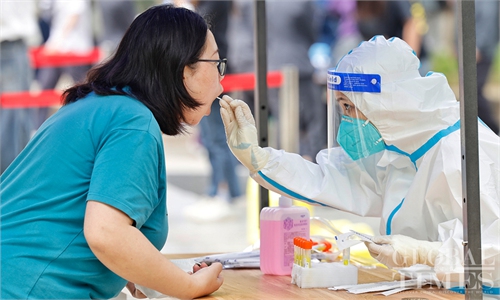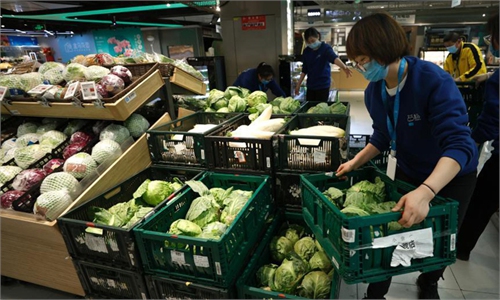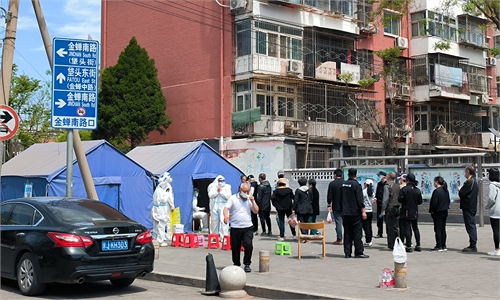Beijing wages critical war against Omicron with largest nucleic acid testing, strictest community management
Learning lessons from Shanghai, Beijing’s fast outbreak control measures to be ‘effective’
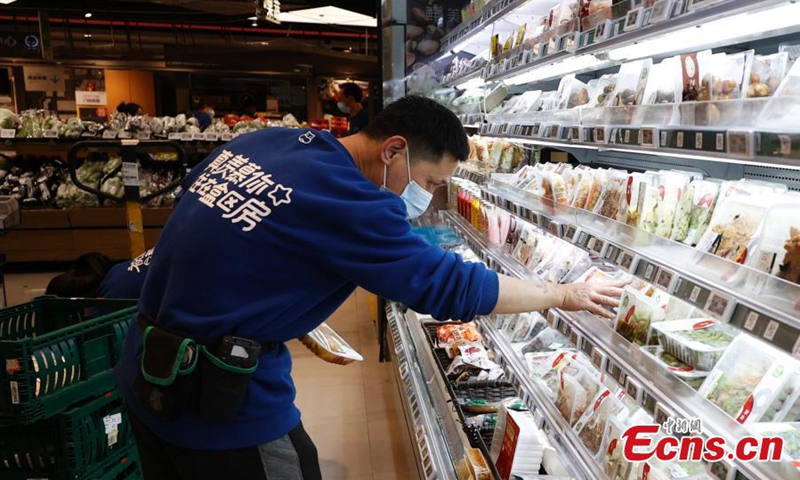
A staff member checks products on a shelf at a Hema Fresh store in Chaoyang District, Beijing, April 26, 2022. (Photo: China News Service/Fu Tian)
Learning the lessons from Shanghai's response to the Omicron resurgence, Beijing is waging a critical and decisive war against the Omicron variant with the strictest measures on community management, largest-ever nucleic acid testing, suspending gathering activities, tracking down transmission routes, and urgently mobilizing the public to ensure the safety of local residents and the country's political center, as the COVID-19 tally in the capital city rose to 92in five days.
On Tuesday, Beijing started one of the three rounds of nucleic acid testing in 11 more districts including Dongcheng, Xicheng and Haidian, making the city's largest testing cover nearly 20 million residents, 90 percent of its population.
The capital city started a district-wide nucleic acid testing in its most populous Chaoyang district on Monday after the emergence of some new local confirmed cases. Two more rounds of testing are scheduled on Wednesday and Friday in the district. Chaoyang has tested around 3.8 million residents in first round, with one group of five samples testing positive.
Beijing on Tuesday reported 22 more COVID-19 infections, including one asymptomatic infection, from 4 pm Monday to 4 pm Tuesday, bringing the total to 92 since Friday.
Haidian, with the most schools and colleges in the city, tested more than 700,000 residents in the first four hours on Tuesday. A student from the Renmin University of China surnamed Yang told the Global Times that as the university has set up testing rooms and tables for its regular testing, students could quickly finish the testing after booking a testing period on an app in advance.
On Tuesday, sports venues, culture centers, scenic spots and group tourism were either halted or the numbers of visitors were capped.
The Beijing Municipal Bureau of Sports ordered on Tuesday a suspension of all sports events, and extracurricular sports training activities from Tuesday to Saturday. It also asked sports venues to limit the number of visitors to avoid large-scale gatherings, and to test some of their employees at least once a week.
The Beijing People's Art Theatre in Dongcheng said it had canceled all performances scheduled between Tuesday and Saturday. The Yonghegong Lama Temple in Dongcheng also announced it will be closed starting Wednesday.
As the capital entered a critical period for its epidemic control and prevention, Beijing's Party chief Cai Qi called for urgent mobilization, fast screening, strict and decisive measures to resolutely curb the virus spread and ensure the safety of residents and the capital at a meeting on Monday, Beijing Daily reported on Tuesday.
A senior expert from the Chinese Center for Disease Control and Prevention (Chinese CDC) told the Global Times on condition of anonymity on Tuesday that apart from nucleic acid testing, there is no other way to find out how far the Omicron has spread and who have been infected, especially considering that the stealth variant is harder to track.
As the capital city and political center, Beijing must take faster and stronger epidemic prevention and control measures, the expert said. He said the largest ever nucleic acid testing covered nearly 20 million residents.
So far, the latest outbreaks included cluster infections related to dining, a school, some interior decoration workers and a tour group.
Among the newly reported cases on Tuesday, five were students, making the total number of students infected in the latest outbreak to 26, according to media reports.
At Tuesday's press conference, a Beijing official stressed the importance of dealing with local schools where infections had been found, saying they are vital spots in the epidemic prevention and control work.
On Tuesday afternoon, many schools in Haidian said they would stop providing services from training agencies inside or outside the schools and employees from outside training agencies would be banned from entering the schools.
A residential community in Haidian issued a notice requiring residents who had visited or worked in two local schools to stay at home for 14 days.
Wang Guangfa, a respiratory expert at Peking University First Hospital, told the Global Times that multiple transmission chains would make it harder for Beijing to put the the ongoing epidemic under control. But the city's rapidly arranged mass nucleic acid testing in different districts would help to screen infections in a timely manner and take them to quarantine or treatment, Wang said.
Zeng Guang, former chief epidemiologist of the Chinese CDC, told the Global Times on Tuesday that Beijing is drawing lessons from Shanghai's response to COVID-19 with fast testing and strict and timely measures. As a megacity, Beijing also faces challenges such as blurred district boundaries in epidemic control.
For example, people from many different districts work in Chaoyang, increasing the difficulty in managing companies and organizations in the district, Zeng said.
Shanghai has reported more than 500,000 infections since late February in the latest outbreak.
As for the future development of Beijing's current outbreak and whether it may have to face a similar situation, Zeng said that several cities and provinces experienced outbreaks similar to the one in Beijing, but they did not turn to large-scale lockdowns like the one in Shanghai.
With strict measures taken at an early stage, the senior expert said, Beijing could curb the spread of the virus effectively.
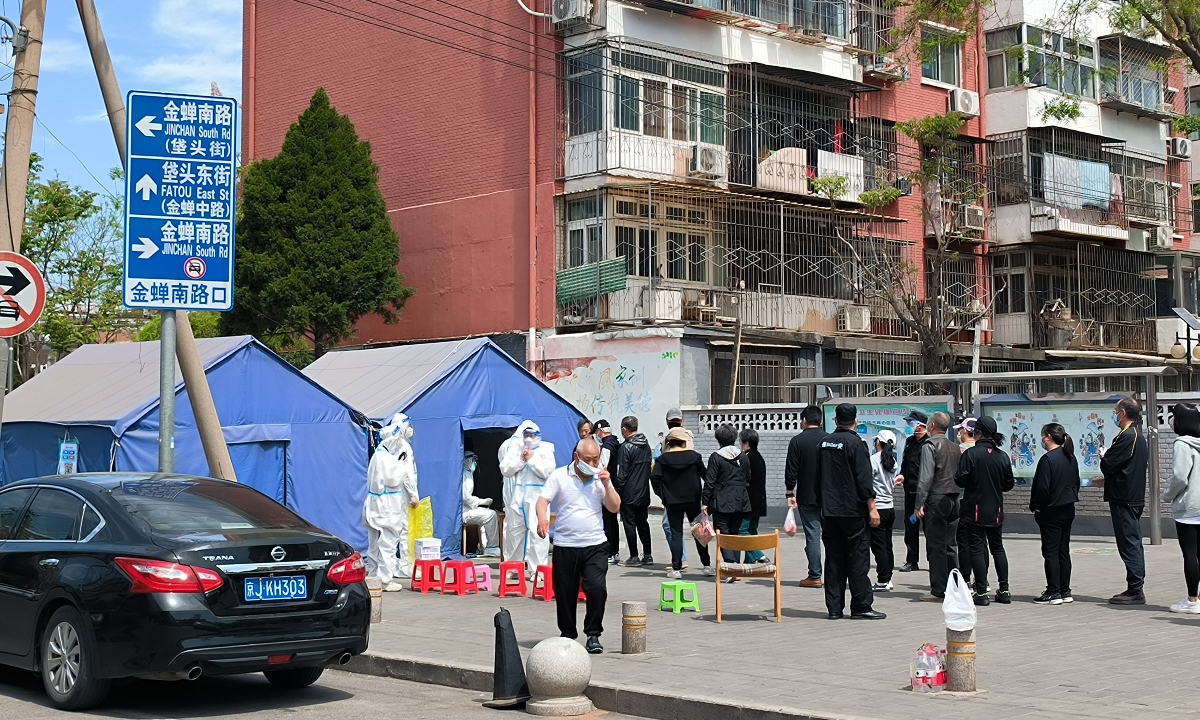
Beijing reports four newly confirmed COVID-19 cases and 10 silent coronavirus carriers on Friday. Photo:VCG
Forward planning
The implementation of the strict and timely measures also reflected the Beijing government's strong governance capability in mobilizing the public and making plans ahead, analysts said.
Many districts mobilized Party members, community residents, civil servants, police officers as well as nearby company employees to help maintain order or assist seniors in nucleic acid testing. The Haidian district government mobilized 7,200 civil servants from government organs to support the nucleic acid testing on Tuesday.
Beijing has a total of 286 nucleic acid testing institutions with a daily testing capacity of 1.68 million tubes as of January, according to the Beijing health commission. Current district-wide tests usually mix five or 10 samples in one tube.
Beijing has more than 60,000 people eligible to perform nucleic acid testing and they could be mobilized in a short time, the commission said.
Wang said that it is still too early to predict how the epidemic would grow, but Beijing should make full preparations in advance. Based on experiences from other places' fight against the Omicron variant, he suggested that the Beijing authority should prepare a certain number of designated hospitals and some makeshift hospitals if confirmed cases continue to grow.
Beijing is one of the places in China that has the highest vaccination rate. According to data released by the local authority in January, 98 percent of Beijing residents had been vaccinated.
For people aged 60 and above, more than 80 percent had received at least one shot and most of them had accepted booster shots as of April 17.
Wang said that the high vaccination rate would help protect Beijing residents from severe diseases and deaths during outbreaks.
China's Omicron-specific vaccine has achieved progress on Tuesday as an Omicron-specific COVID-19 vaccine candidate developed by Sinopharm has been approved for clinical trials by China's top drug regulator.
The experimental inactivated vaccine, if successful, is likely to be used as a third or fourth booster shot for fully vaccinated people aged 18 years and above.
